|
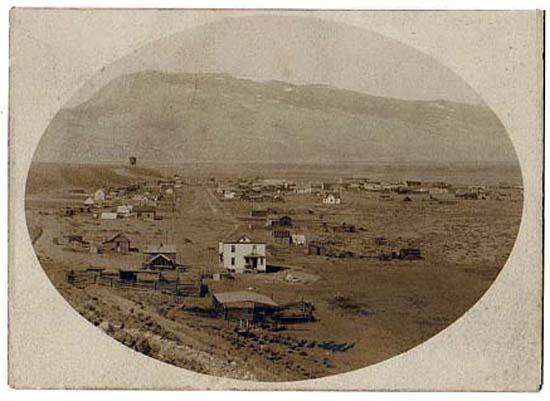
Cody, Wyoming, approximately 1900.
Although the Town of
Cody had less than 50 buildings at the time of the opening of the Irma Hotel, and
ten of those buildings were saloons, the town was equipped with the latest modern amenities including
electricity, and a water and sewer system. Note the water tank on top of the hill in the above photo. The town remained, however, primarily agricultural, spurred on in part
by the Col. Cody's Shoshone Land and Irrigation Company.
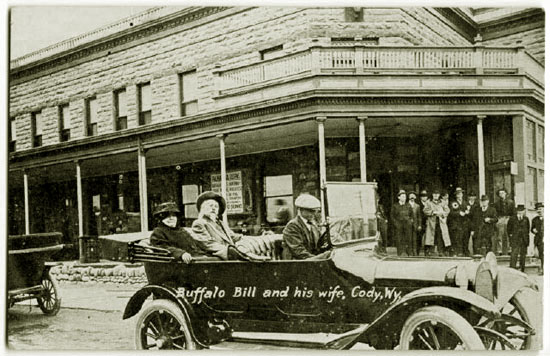
Wm. F. Cody and Louisa Cody in front of Irma Hotel.
Note that the motorcar is right-hand drive. Although most American territories drive on the right, except
the American Virgin Islands, the steering wheels of American automobiles used right-hand drive until Henry
Ford switched to Left-hand drive in 1908. Other manufacturers followed suit. The last two
American manufacturers to switch were Pierce-Arrow in 1920 and Stutz in 1921. Archeological evidene has been found
that the British have been driving on the left since Roman times. One of our British cousins attempted to
convince the writer the rightness of the following British doggerel by asking upon what side of a horse the writer mounts:
"The law of the road is a paradox quite
As you're driving your carriage along
If you go to the left
you're sure to go right."
A simple response is that if one mounts one's vehicle from the left, it makes sense for the steering wheel to be also on the left.
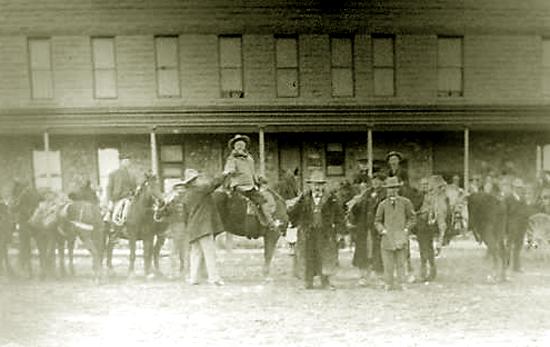
Wm. F. Cody and group in front of Irma Hotel.
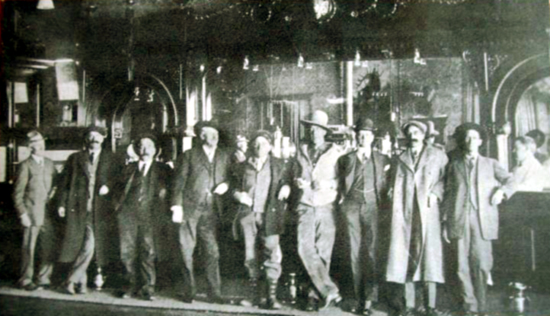
1907 gathering in the bar of the Irma.
Left to Right: Frank O. Thompson, Postmaster; Henry J. Fulton, stockgrower and banker;
Alfred Heimer, Col. Cody's personal chef; Col. Cody; Harry Sanborn; Earl Pulley; Harry R. Weston, cashier of the First National Bank and
assistant treasuer of Cody's Shoshone Land and Irrigation Company; Ted Hogg, brother of stockgrowers and bankers William T. Hogg and Adam
Hogg; and Charley James.
Al Heimer was originally employed in New York by Col. Cody as a steward for Cody private railway car.
He bacame chef for the Wild West show and later constructed the Rex Hotel in Billings, Montana.
Col. Cody persisted in calling Heimer "Albert" although his actual name was Alfred. Weston became cashier of the
bank after cashier Ira Otis Middaugh was killed in an attempted 1904 robbery of the bank. He later moved to
Jackson and became state treasuer in 1931. Although he was relatively unknown, Weston became the Republican candidate for
governor in 1932. He lost. The backbar in the photo was made of cherry and was a gift to
Col. Cody from Queen Victoria. It is presently in the dining room of the Irma serving as the
backbar to the lunch counter.
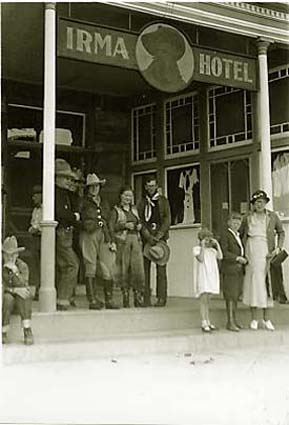 . . . .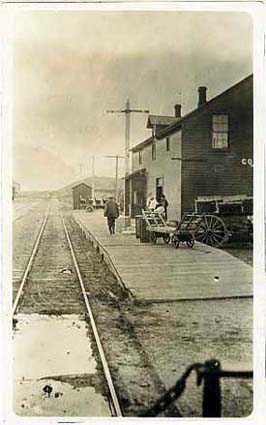
Left, Front entrance Irma Hotel, 1930's
Right, Railroad depot, approx. 1910
The Irma Hhotel originally featured a series of Queen
Ann style windows on the Sheridan Avenue side. See above photo. In various renovations after the
hotel was opened, the windows were removed. Some of windows may be seen in the
local Holiday Inn. In addition, Cody maintained an office in the hotel and
two suites.
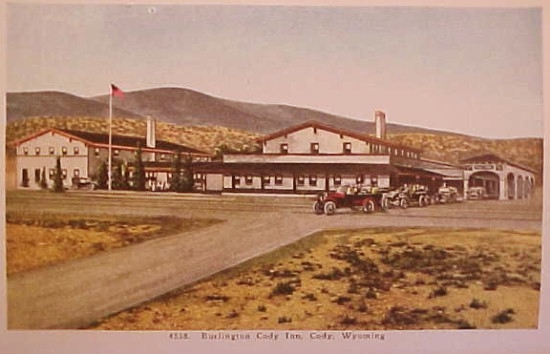
Burlington Depot and Inn, approx. 1927
As a result of Cody's interest in the area, the Burlington
System extended a spur to Cody in 1901. Even after the arrival of the railroad, the 130 mile ride from
Toluca, Montana, was still an all day trip. Toluca, itself, was described by big game hunter A. H. Cordier
as consisting of a "depot, a section house two Cody hotel signs and a large prairie dog population." Dr. Cordier noted that the
length of the journey included stops the "engineer and fireman made when they went to shoot prairie chickens along the right of way."
Cody was, according to Dr. Cordier, was more animated because of the ranchmen, miners and cowboys than its size would otherwise
indicate.
Col. Cody envisioned tourists arriving in
Cody by train and then traveling by stage to Yellowstone up a road following the
Shoshone River and staying in the Pahaska Tepee and Wapiti Inn. On the return, he envisioned the
tourists staying in the Irma.
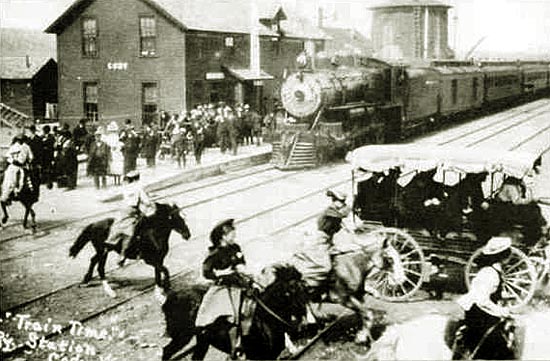
"Train Time" at Cody.
In 1927, the railroad by-passed Cody's hotels and constructed the Burlington
Inn.
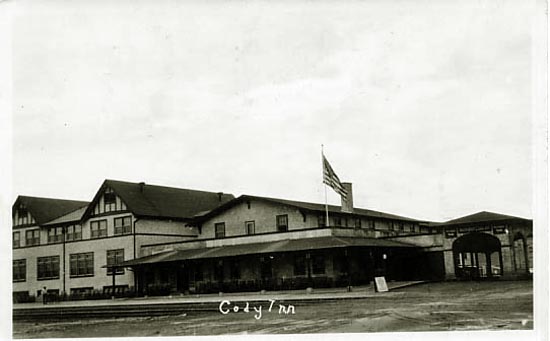
Burlington Inn 1930's
The Burlington Inn had 90 rooms. The dining room could hold 400 to 500 persons. The Inn only operated seasonally
when the road to Yellowstone was open. It following World War II. Its backbar is now on display in the
Meeteetse Museum. Before World War II, the
tourists arrived by train, traveled up the Cody Road to Yellowstone and when they returned they
stayed at the Burlington Inn. As many as 50 busses would wait for the arrival of a train to take the the
tourists to Yellowstone.
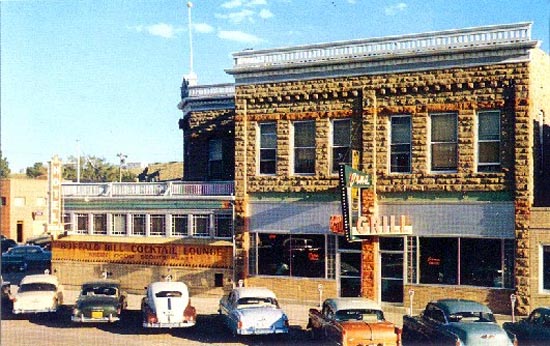
Irma Hotel, approx. 1955
Following Cody's death, the hotel continued to be operated by
Cody's widow, Louisa and her son-in-law Fred Garlow. On March 11, 1918, a private at Fort
Riley, Kansas, reported to the Post hospital complaining of a fever, sore throat and headache. By noon
more than 100 soldiers also reported to the hospital with the same symptoms. By the end of the week more than
500 had come down with the same malady. Over the next months, the Spanish Influenza swept the country infecting
some 28% of all Americans and causing the death of an estimated 657,000. World-wide it has been
estimated that 20 to 40 million died. More American troops in Europe during World War I died from the
influenza than were killed by German action. The disease had a strange impact. It killed those in the
prime of life between ages 20 and 40 but in most instances those younger and
older were not affected as seriously. In October in the United States, some
195,000 died. By October, the flue was in Wyoming. Worland reported some 20 cases by October 10.
In one week alone, 14 died in Washakie County. Among those in Cody who died in October were Irma and her husband Frederick Garlow, leaving
Louisa Cody to rear three young children. Louisa died in 1921 and the hotel was
sold in 1925 to Henry and Pearl Newell.
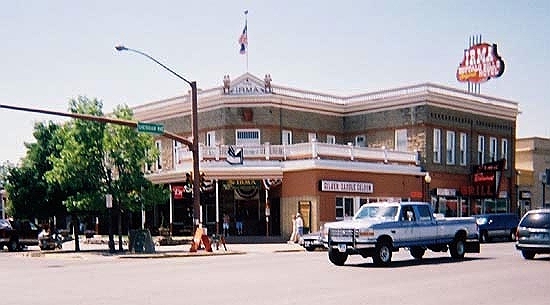
Irma Hotel, 2003, photo by Geoff Dobson
The Irma, still in business, was the first of three hotels, strategically located to
serve tourists on their way to Yellowstone. A day's journey toward
Yellowstone was the Pahaska Tepee, pictured with regard to the
Cody Road, and a half day's journey was the
Wapiti Inn. The Pahaska is still in existence. The Wapiti, however, was torn down in
1913. Parts of its materials were, however, used in an addition to the Pahaska.
Next Page: Cody continued.
|